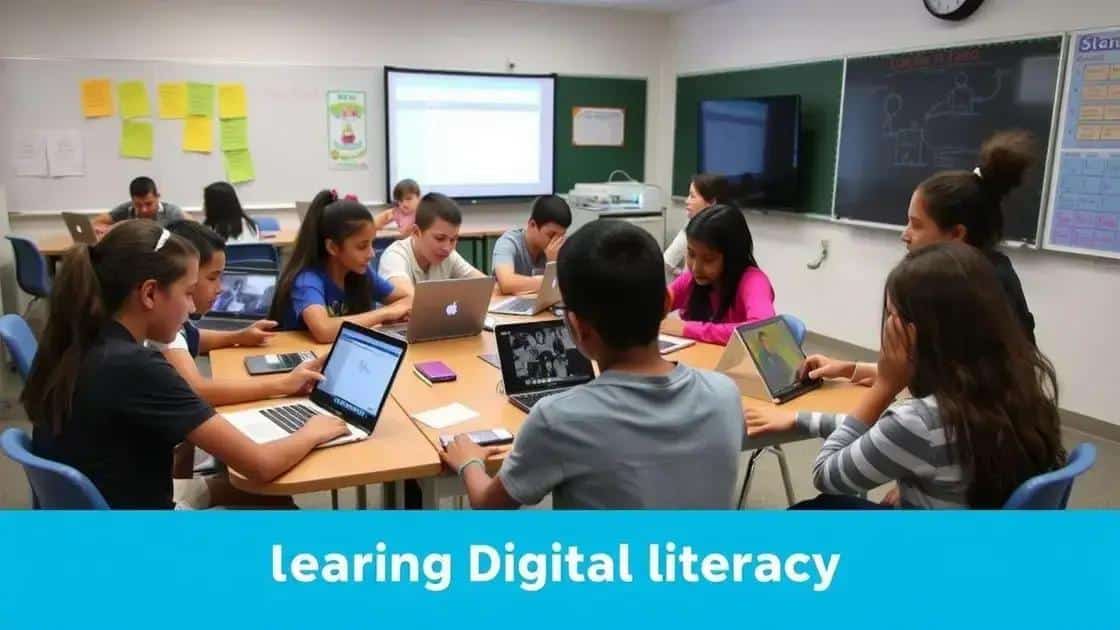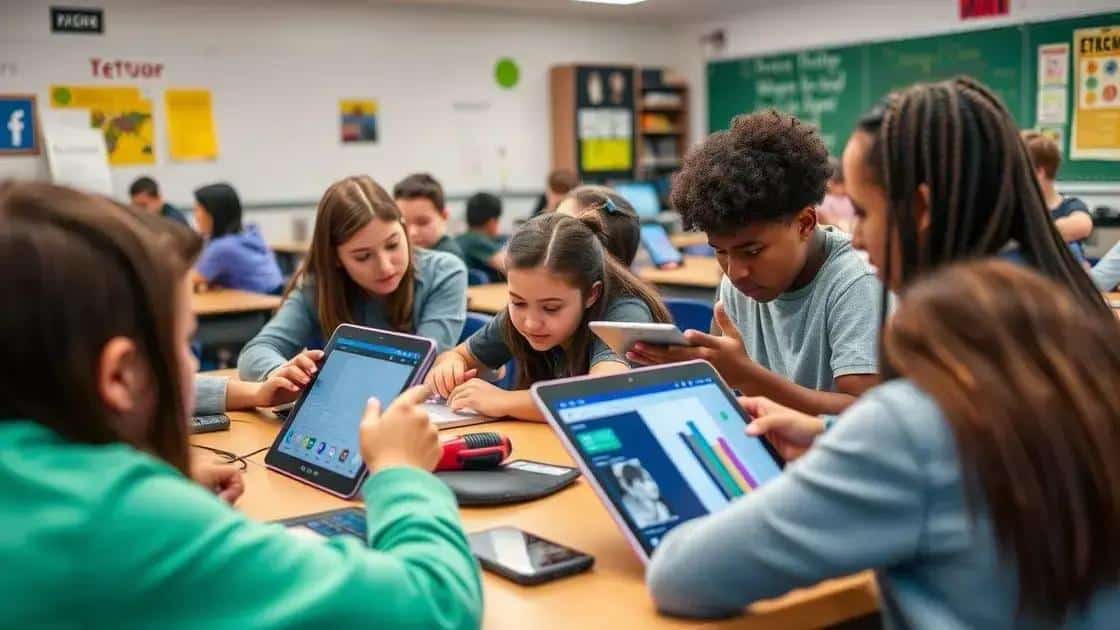Digital literacy curriculum trends: what to expect

Digital literacy curriculum trends focus on integrating technology and enhancing skills like information evaluation, online communication, and collaboration, preparing students for success in a progressively digital world.
Digital literacy curriculum trends are crucial in today’s technology-driven world. Have you ever wondered how these trends affect our learning processes? Let’s explore together.
Understanding digital literacy
Understanding digital literacy is essential in our tech-centric world. It goes beyond just knowing how to use a computer; it encompasses the ability to navigate the internet, evaluate sources, and communicate effectively online. This skill is vital for both personal and professional success.
Key Aspects of Digital Literacy
Several elements contribute to a well-rounded sense of digital literacy. It’s important to recognize these components:
- Information literacy: Knowing how to locate, assess, and synthesize information from various digital sources.
- Communication skills: Effectively conveying messages through email, social media, and other online platforms.
- Critical thinking: Analyzing online content and identifying misinformation or unreliable sources.
Furthermore, understanding digital literacy enhances collaborative efforts in educational settings. Students engage with peers through shared digital projects, fostering teamwork and innovation. This collaboration not only builds their technical skills but also prepares them for real-world challenges.
The Importance of Digital Literacy
In today’s society, being digitally literate is not just beneficial but necessary. Digital literacy equips individuals with the tools to participate fully in social and professional environments. As technology evolves, so do the expectations for how we communicate, learn, and work.
Additionally, research indicates that individuals with strong digital literacy skills tend to have better job prospects and opportunities for advancement. Emphasizing these skills in curricula ensures that all students are prepared for an increasingly digital future.
Key components of current curricula

The key components of current curricula in digital literacy are designed to equip students with essential skills. These components help learners navigate the digital world effectively. It’s important to understand how these elements work together to create a comprehensive learning experience.
Essential Elements of Digital Literacy
Several vital components form the foundation of effective digital literacy curricula:
- Technical skills: Mastery of basic computer operations and software applications is crucial for students.
- Information evaluation: Students must learn to critically assess sources of information for reliability and bias.
- Online communication: Teaching effective digital communication fosters better collaboration in various platforms.
- Digital ethics: Understanding the importance of online safety and ethical behavior is essential in today’s environment.
Incorporating these elements into curricula can provide students with robust tools that they will use throughout their lives. For example, when students learn technical skills, they are better prepared to engage in digital projects. This preparation not only makes them proficient users but also empowers them to create and innovate.
The Role of Collaboration in Learning
Collaborative learning enhances understanding of digital literacy. By working together, students can share their diverse perspectives and skills. This process makes learning more engaging and effective. Collaborating on digital projects can help reinforce the skills and knowledge gained in the classroom.
Additionally, integrating real-world scenarios into the curriculum encourages students to apply their skills in meaningful ways. For instance, participating in online discussions or contributing to collaborative documents enables students to practice their digital literacy skills in realistic contexts.
Emerging trends in digital education
Emerging trends in digital education are shaping how students learn and interact in the classroom. As technology continues to evolve, so do the methods used in teaching and learning. This evolution allows for more personalized and engaging educational experiences.
Blended Learning Models
One significant trend is the rise of blended learning, which combines traditional face-to-face instruction with online learning. This approach offers flexibility and caters to diverse learning styles.
- Flexibility: Students can learn at their own pace, fitting their study times around other commitments.
- Increased Access: More students can access high-quality resources, regardless of their geographical location.
- Engagement: Interactive online tools can enhance the learning experience and foster greater participation.
Moreover, the use of data analytics in education is becoming increasingly common. Educators can track student progress and adapt their teaching methods based on real-time feedback. This data-driven approach helps identify areas where students may need extra support, ensuring no one falls behind.
Gamification in Learning
Gamification is another exciting trend that leverages game design principles in educational contexts. By incorporating elements like points, badges, and leaderboards, educators can make learning more enjoyable and rewarding. This method not only motivates students but also encourages healthy competition.
In addition, mobile learning is on the rise. With more students using smartphones and tablets, educational content is increasingly being designed for mobile platforms. This shift allows learning to happen anytime and anywhere, making education more accessible than ever.
As we embrace these emerging trends, the future of digital education looks promising. By focusing on innovative methods and technologies, we can create more effective learning environments that positively impact students’ educational journeys.
The role of technology in learning

The role of technology in learning is increasingly significant in today’s educational environments. Technology enhances student engagement and facilitates access to a wealth of resources. It allows learners to explore new subjects and communicate with peers and educators effectively.
Enhancing Engagement
One prominent advantage of technology in education is its ability to increase student engagement. Interactive tools such as educational apps and online games make learning enjoyable. These resources can turn complex topics into fun challenges that captivate students.
- Interactive lessons: Using websites and platforms that allow real-time feedback and participation keeps students interested.
- Multimedia resources: Videos, podcasts, and infographics support various learning styles, making information more digestible.
- Virtual reality: Immersive experiences help students visualize and understand concepts in ways that textbooks often cannot.
Furthermore, technology promotes personalized learning. With various online platforms, students can learn at their own pace, revisiting content as needed. This individual approach ensures that all students, regardless of their skill levels, receive the support they need to succeed.
Collaboration and Communication
In addition to enhancing engagement, technology fosters better communication and collaboration among students and teachers. Tools like discussion boards and video conferencing allow individuals to connect effortlessly, regardless of location. This connectivity prepares students for a global environment.
Moreover, technology encourages group work and collaboration on digital projects. Students can contribute ideas and resources in real time, enhancing cooperative learning experiences. As a result, they develop critical social skills essential for the future.
As we continue to integrate technology into education, we are likely to see an even greater transformation in how students learn. With a focus on adaptability and innovation, technology in learning is set to shape the educational landscape for generations to come.
FAQ – Frequently Asked Questions about Digital Literacy Curriculum Trends
What is digital literacy?
Digital literacy refers to the skills and knowledge needed to effectively navigate and use technology and the internet for learning, communication, and problem-solving.
How does technology enhance learning?
Technology enhances learning by providing interactive tools, personalized learning options, and access to a wide range of resources that increase engagement and understanding.
What are some key components of effective digital literacy curricula?
Key components include technical skills, information evaluation, online communication, and digital ethics, all of which prepare students for success in a digital world.
Why is collaboration important in digital education?
Collaboration fosters teamwork and communication skills, enabling students to work together effectively, share diverse perspectives, and develop critical social skills.





